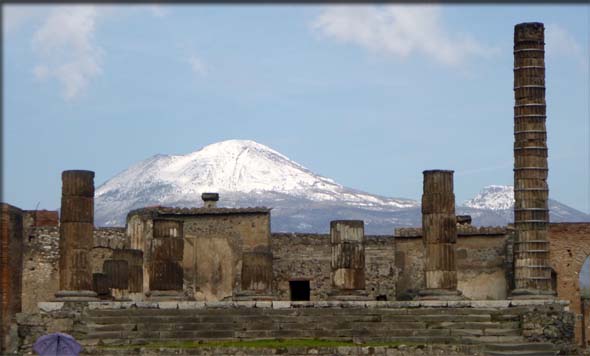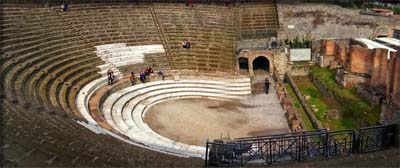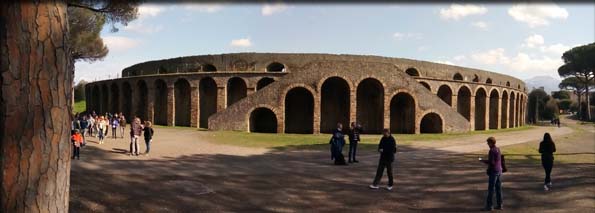A
Visit to Pompeii: A City Frozen in Time
|

Mt.
Vesuvius rises behind the ruins of Pompeii's forum.
(Copyright Lee Krystek, 2018)
|
On August 24th, 79 AD, the volcano Vesuvius erupted
along the west coast of what we now call Italy. Among the casualties
of that event was the middle-class port town of Pompeii. In
the course of a few days, the city went from a bustling metropolis
to a time-capsule of ancient Roman life, buried under dozens
of feet of volcanic ash, and not seen again until modern times.
The naturalist, Pliny the Elder, was an official
of the Roman Court and in charge of the Fleet in the Bay of
Naples during the eruption in August of 79 AD. He had a house
across the bay from Pompeii with an excellent view of the mountain.
According to an account by his nephew, Pliny the Younger, "my
mother drew his attention to a cloud of unusual size and appearance.
He had been out in the sun, had taken a cold bath, and lunched
while lying down, and was then working at his books. He called
for his shoes and climbed up to a place which would give him
the best view of the phenomenon. It was not clear at that distance
from which mountain the cloud was rising (it was afterwards
known to be Vesuvius); its general appearance can best be expressed
as being like an umbrella pine, for it rose to a great height
on a sort of trunk and then split off into branches, I imagine
because it was thrust upwards by the first blast and then left
unsupported as the pressure subsided, or else it was borne down
by its own weight so that it spread out and gradually dispersed.
In places it looked white, elsewhere blotched and dirty, according
to the amount of soil and ashes it carried with it."
|

The
Pompeii Theater (Copyright Lee Krystek,
2018)
|
It soon became apparent that this phenomena was
causing great destruction to settlements near the mountain.
Pliny the Elder ordered his fleet across the bay to try to assist
those fleeing the eruption. He himself would die during this
rescue mission.
In the city of Pompeii, 5 miles south of the
mountain, most people abandoned their homes and fled the city
as ash and thick dust began to blanket the streets and buildings.
This was wise, because what would happen next would bring all
life in the town to an end.
At some point a number of hours into the eruption,
a mass of superheated poisonous gas vomited out of the volcano
and rushed down the mountain engulfing Pompeii, and its sister
city of Herculaneum in 482 °F (250 °C) vapors that caused instant
death to the estimated 2,000 people still in the city.
The volcano continued to spew ash, eventually
covering the city's buildings and the dead inside them. When
the volcano finally settled down. no trace of the town was left
and the city of Pompeii was eventually forgotten.
Rediscovery
|

The
victims, killed instantly by a wave of superheated air,
were covered by ash and when their bodies decayed a void
was created. Fiorelli figured how to fill the void with
plaster in the position the victims were in when they
died. (Copyright Lee Krystek, 2018).
|
During 1599, some of the remains were found during
the excavation of a tunnel to divert water from river Sarno,
but major work didn't get underway until 1748 when Spanish military
engineer, Rocque Joaquin de Alcubierre, started excavations
following Spain's regaining control over the region a few years
earlier. The King of Spain, Charles of Bourbon (who also ruled
the nearby city of Naples), found the archeological discoveries
of great interest. Since that time Pompeii has been slowly excavated,
with about two thirds of the site exposed at the current time.
Giuseppe Fiorelli, who took charge of the excavations
in 1863, made one of the most macabre discoveries about the
city. He kept finding voids in the ash, and inside those voids,
human bones. He finally determined that this is where victims
of the superheated air had died and their remains had been covered
with ash. As their bodies decayed over time, the space became
empty. He decided by injecting wet plaster of Paris into the
spaces, he could capture the positions of the people as they
expired.
Pompeii
Today
A visitor entering the main gate (closest to the
Circumvesuviana metro stop) at the site climbs up a long Roman
road from the ticket booths until he enters the town's forum.
The forum, which was a large central square in the center of
the city, was the heart of the town and contained an open air
market surrounded by public buildings such as the temple of
Jupiter and the equivalent of a city hall.
Surrounding the forum were streets in a grid pattern
running in every direction to the outlying sections of the city.
Paved with large stone blocks, the streets were designed to
be flushed with water so they could also serve as the city's
drainage and waste disposal system. Large stepping stones were
placed at each intersection, allowing the town's citizens to
cross the street without getting their feet wet. Spaces between
the blocks allowed chariots and other wheeled vehicles to move
down the street unimpeded. Visitors can still see ruts in the
roads where the blocks have been worn down by countless, ancient
vehicles rolling over them.
|

This
counter top was the front of a ancient "fast food"
shop. (Copyright Lee Krystek, 2018).
|
This reminds visitors that the city was well established
at the time of its destruction. Pompeii had been founded nearly
700 years previous to Vesuvius destroying it. As you explore
the remains, it is evident that the people who lived there were
more like us than we might think. Scattered along the streets
of the site are the remains of "fast food joints." These buildings
are easily recognized by the waist-high, marble counter-tops
with circular holes in them meant to contain cooking pots. Many
of the citizens of ancient Pompeii couldn't cook in their small
apartments, but used these convenient places to pick up a meal.
Running
Water and Baths
As many modern cities have running water, so did
Pompeii. At the time of the eruption, an aquaduct brought water
into the city and it was then distributed via a set of lead
pipes. About ten percent of the houses had water delivered directly
to them, while the rest of the water went to public fountains
where citizens could get water for their homes. The public baths
consumed a significant amount of the water supply, too.
|

Ruts
made by Roman chariots and wagons can still be seen in
the streets. (Copyright Lee Krystek,
2018).
|
The public baths were an important social spot
in any Roman city and Pompeii was no exception. The baths were
located just off the forum and included locker rooms for undressing,
pools and a sauna. The sauna was cleverly heated by hot air
from fires channeled around the room through double walls and
a false floor. Water from a pool created steam in the room.
A number of private houses have also been preserved
in the city. Many follow a standard rectangular, design usually
with no external windows, but an open courtyard inside that
gave the rooms around the edges light. Water from the roofs
were channeled into a pool, or mpluvium, in the center of the
courtyard. Rooms around the colonnade surrounding the courtyard
were usually bedrooms, while toward the back of the courtyard,
furthest away from the street, was a dining room. In the back,
some houses included a garden. If the owner was a merchant,
there might also be rooms for meetings or workshops.
The city also contained an impressive theater
and a stadium capable of seating nearly 20,000 people.
Even today Vesuvius dominates the horizon, though
much of the mountain was blown off in the eruption. While clearly
visible from the city, Pompeii is not located at the base. The
mountain is five miles away, a testament to the power of the
volcano to destroy the city even at that distance.
In fact, Vesuvius and the Phlegrean Fields, an
ancient supervolcano just beyond the densely populated city
of Naples, continue to make the area of Pompeii seismically
active and potentially dangerous. Ironically, a future eruption
may someday bury the city again under a blanket of ash and it
will, perhaps forever this time, disappear from history.
|
The
city's stadium. (Copyright Lee Krystek,
2018).

|

Copyright Lee Krystek 2018. All Rights Reserved.